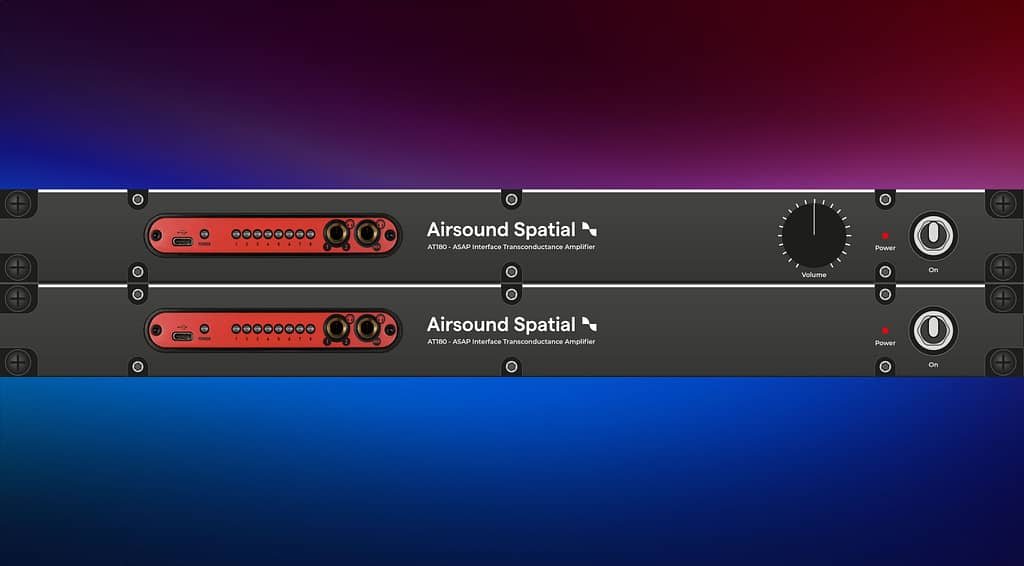by Ted Fletcher
The AT180 amplifier forms the core of the Airsound Spatial audio system and is currently under development.
HISTORY
The original AT180 amplifier design was developed by Ted in 1974 as an idea to improve the fidelity of a BBC studio talkback system(!). As a clever but unusual design it remained almost unused until re-developed by Ted and Daniel in 2010 as the main midrange amplifier in the Orbitsound D1 HiFi loudspeaker system. Further research at ‘The Sound House’ in Torquay pointed towards the revolutionary design having huge practical advantages over conventional amplifier/loudspeaker arrangements.

THE ’SECRET’
The design revolution is the way the power amplifier and the loudspeaker work together. A power amplifier normally amplifies sound and presents power to a loudspeaker which in turn converts the power into audible sound. The final sound is a good representation of the original sound but contains audible distortions both from the amplifier and from the inaccuracies in the way loudspeakers work.
In the AT180 system the loudspeaker becomes an integral part of the amplifier. Errors in the amplifier, the loudspeaker and its interconnections are cancelled out and the incoming audio is converted directly into audible sound so that what is heard is an exact replica of the original incoming audio.
IMPROVEMENTS
The immediate first impression of the AT180 system is the extreme ‘presence’ of the sound, this is made possible by the almost complete removal of acoustic distortions together with an extended frequency response range. A secondary effect is a cleanness and lack of background noise due to the AT180 ability to damp unwanted harmonics.
AT180 ADVANTAGES.
- Up to 95% reduction in total harmonic distortion in acoustic output.
- Effective damping and loudspeaker control.
- One octave extension of frequency range.
- No limit to diameter or length of loudspeaker cable.
THE TECHNOLOGY
Those who ‘know about’ Hi Fi often accept the fallacy that amplifiers are best if they have very high Damping Factors. The reasoning is that a high Damping Factor presents a zero impedance to the loudspeaker which effectively ‘damps’ any unwanted harmonic movements; back EMFs are shorted out by what is effectively a short circuit.
The arguments are logical and believable, except that they are less than correct for two main reasons. 1) A loudspeaker cone has a resonant frequency, and at that frequency a short-circuit across the coil does have a significant effect on how the loudspeaker returns to a rest state, but at frequencies above and below the resonant frequency there is little or no effect. 2) The output impedance of an amplifier is stated in ohms. For a damping factor of say 40 (a modest figure for a Hi Fi amplifier) the output impedance is 0.1 ohms. It is likely that the cables connecting the loudspeaker have a resistance of about the same, so the damping factor has been halved immediately. At points along the coil within the loudspeaker driver, there is significant resistance, so the damping factor has been degraded to a point where it is probably about 2 or 3, hardly of much use for ‘damping’ even if it was effective for controlling cone movement.
AT180 LOUDSPEAKER CONTROL
The power section of the AT180 amplifier produces an output whose current is exactly proportional to its input voltage regardless of external factors (transconductance); its output has no ‘damping factor’ in the conventional sense; output impedance has no meaning because the amplifier’s function is to drive current, irrespective of any conditions of the ‘load’ which is our loudspeaker. The loudspeaker ‘sees’ the amplifier as an open circuit, yet at the same time it is being fed by a tightly controlled current that is unaffected by any factors in the loudspeaker. The coil of the loudspeaker moves (accelerates) in exact proportion to the current in the circuit, and that current is the same at all points in the circuit (Kirchoff’s Law).
The coil and diaphragm of the loudspeaker react precisely to the current and as the production of sound is a result of physical acceleration, movement effects (harmonics) try to take place physically in the form of resonances in the moving parts, BUT the coil and diaphragm can only move proportionally to the current, so they cannot reproduce those harmonics and so they do not appear as sound! So unwanted harmonics and distortions are suppressed by the physics of operation of the AT180; the loudspeaker is perfectly controlled and ‘damped’ at all audio frequencies!
SUMMARY
A conventional amplifier is designed to produce an AC voltage that is exactly proportional to its input voltage. The resulting audio from the loudspeaker is subject to distortions primarily because in the loudspeaker circuit the currents and voltages vary, offering changing impedance which affects the current presented by the amplifier, altering the response of the coil; the electrical conditions around the loudspeaker coil are complex and unpredictable. The sound output can be mildly affected by damping factor, but not significantly or necessarily for the better. The AT180 overcomes these problems producing accurate undistorted audio.